1 Furnaces
In Unit K-1, we first looked at residential HVAC systems, we looked at gas, oil and electric furnaces, as well as heat pumps. We also looked at different unit configurations including upflow, downflow, lowboy and horizontal. 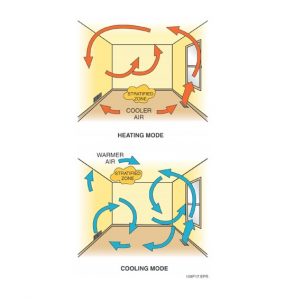 When we deal with heating systems, we want to deliver the air at a low level because warm air rises. This is a vital concept in HVAC work. When we deliver the warm air near the floor it causes a natural circulation in the room, mixing the air to achieve a balanced temperature. This would be the opposite for cooling systems.
When we deal with heating systems, we want to deliver the air at a low level because warm air rises. This is a vital concept in HVAC work. When we deliver the warm air near the floor it causes a natural circulation in the room, mixing the air to achieve a balanced temperature. This would be the opposite for cooling systems. 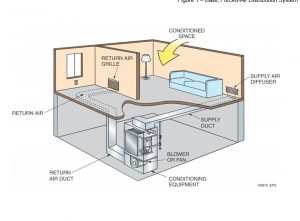 Each of these configurations can accomplish this for different installation requirements.
Each of these configurations can accomplish this for different installation requirements.
Upflow/Highboy 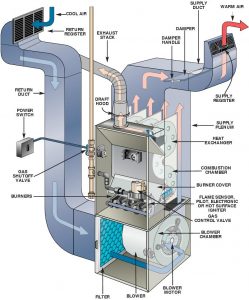 An upflow configuration has the supply air exiting the top. This configuration is best suited for 2 story homes, with the unit placed on the first floor. This way the supply air is delivered at the floor level of the 2nd story or main living space, producing natural circulation.
An upflow configuration has the supply air exiting the top. This configuration is best suited for 2 story homes, with the unit placed on the first floor. This way the supply air is delivered at the floor level of the 2nd story or main living space, producing natural circulation.
Downflow/counter flow 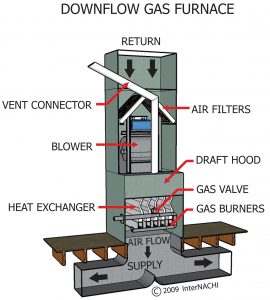 A downflow or sometimes called a counterflow furnace is the opposite of an upflow, with supply air exiting the bottom. This configuration is well suited for 1 story homes, where the supply can be delivered at the floor level. The furnace is located on the floor level with the ductwork either in a crawlspace, or embedded in the concrete floor of the home. The concrete floor of this type of home is called slab on grade and the ductwork within the concrete is called slab duct.
A downflow or sometimes called a counterflow furnace is the opposite of an upflow, with supply air exiting the bottom. This configuration is well suited for 1 story homes, where the supply can be delivered at the floor level. The furnace is located on the floor level with the ductwork either in a crawlspace, or embedded in the concrete floor of the home. The concrete floor of this type of home is called slab on grade and the ductwork within the concrete is called slab duct.
Lowboy 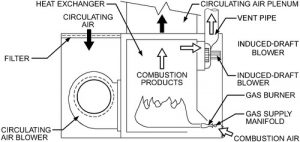 A lowboy furnace is best suited the same as the upflow, but where the head room of the first floor is limited. Because the side by side arrangement, this configuration will still supply the air to the 2nd floor, but the cabinet will be much lower than in an upflow design.
A lowboy furnace is best suited the same as the upflow, but where the head room of the first floor is limited. Because the side by side arrangement, this configuration will still supply the air to the 2nd floor, but the cabinet will be much lower than in an upflow design.
Horizontal 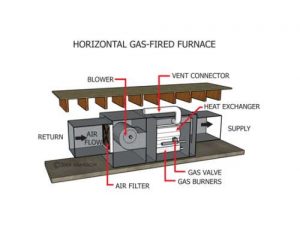 In a horizontal furnace, the air flows in a horizontal fashion, from side to side. This allows the unit to be located in an area with very little space, such as an attic or crawlspace. If this unit is placed in an attic, the supply for a heating system will still need to be delivered near the floor, so oval or “wall stack” ducting may be used to run the duct in the walls down to the floor level. If it is primarily used for cooling mode, the duct is already in place to run through the ceiling.
In a horizontal furnace, the air flows in a horizontal fashion, from side to side. This allows the unit to be located in an area with very little space, such as an attic or crawlspace. If this unit is placed in an attic, the supply for a heating system will still need to be delivered near the floor, so oval or “wall stack” ducting may be used to run the duct in the walls down to the floor level. If it is primarily used for cooling mode, the duct is already in place to run through the ceiling.
Draw through/Blow through 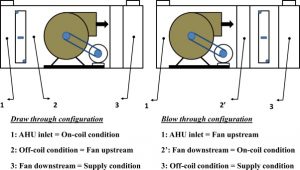
A draw through unit is when the air is being drawn or pulled across the heat exchanger. A draw through can be seen on heat pump air handlers. Even though this changes the way that the blower and heat exchanger are located, they are still considered upflow, downflow, lowboy or horizontal depending on where the air enters and exits. The second type is a blow through, when the air is being blown across the heat exchanger. All of the configurations shown above are considered blow through units.
